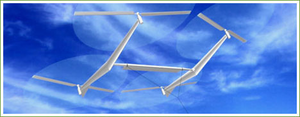Energy futuresThe best place for a wind turbine: 30,000 feet above ground
At altitude of 2,000 feet (610 meters), wind velocity is two to three times greater than at ground level; since power production goes up with the cube of that wind velocity, this means that at 2,000 feet above ground, wind produces 8 to 27 times the power produced by wind at ground level; if we send turbines farther aloft, into the 150 mph (240 kph) jet stream at 30,000 feet (9,150 meters), than power production grows from 500 watts per meter for ground-based wind turbines to about 20,000, 40,000 watts per square meter; this is very high energy density — and NASA is examining the project’s feasibility

Artist rendering of a wind turbine at 30,000 feet // Source: newenergydirection.com
In Mark Moore’s world, long nanotubes reach into the clouds, serving at once to tether a turbine-vehicle flying at 2,000 feet, or 10,000 feet, or 30,000 feet (610, 3,050 and 9,150 meters); and also to conduct the power that vehicle can harvest from the wind back to Earth.
Aloft might be a funnel-shaped blimp with a turbine at its back; or a balloon with vanes that rotate; a truss-braced wing; a parachute; a kite. Any and all of them are ideas being considered by nascent renewable energy industry that is flexing its imagination.
Moore, who works as an aerospace engineer, centering his focus on advance concepts in the Systems Analysis Branch at NASA’s Langley Research Center, is using a $100,000 grant from the federal government to research what it will take to judge the value of any of those ideas.
“It’s the first federally funded research effort to look at airborne wind capturing platforms,” Moore said. “We’re trying to create a level playing field of understanding, where all of the concepts and approaches can be compared — what’s similar about them? What’s different about them, and how can you compare them?”
He likens the development of wind-borne energy to flight itself, adding that “this is like being back in 1903. Everybody’s got a dog to show. Everybody’s got a different way of doing it?”
The Wright Brothers, though, did not have to deal with a crowded sky and the laws regulating it when they took off at Kitty Hawk. When they invented the airplane, they also created competition for airspace that makes creating air-borne power generation much more difficult.
“Airspace is a commodity,” Moore said. “You have to be able to use airspace without disrupting it for other players. Smaller aircraft are still going to need to fly around. Larger airplanes, you can’t expect them to fly around every wind turbine that has a two-mile radius as a protected flight zone.”
It is another issue in considering air-borne power generation, which Moore hastens to say it not THE answer to clean energy but deserves consideration in a mix that includes solar power, ground-based wind turbines, algae and the other solutions both realistic and exotic that are being worked upon by scientists and engineers.
None has approached the cost of fossil fuel energy for thrift, but Moore argues that cost takes on a new dimension when all of its factors are considered, including the amount of land used
